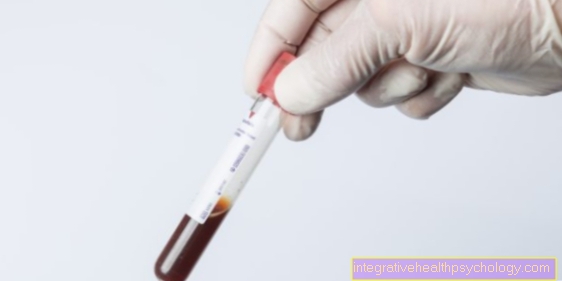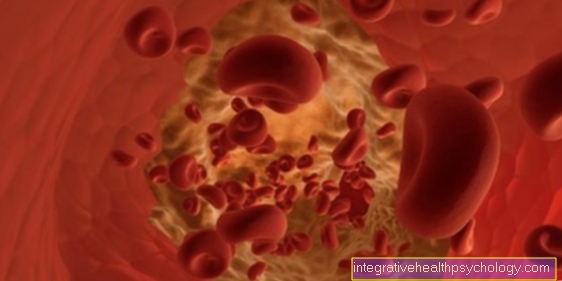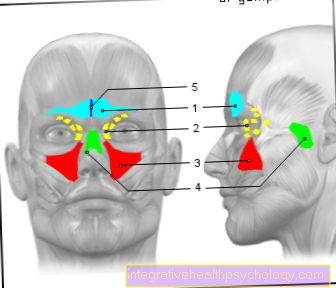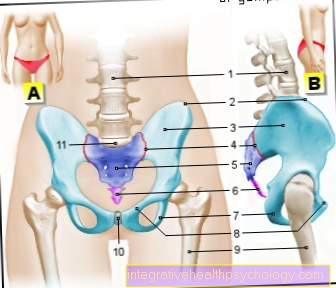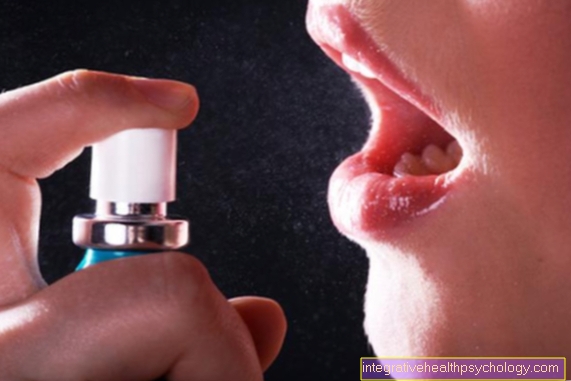Type 2 diabetes mellitus
Synonyms in a broader sense
Diabetes mellitus, diabetes, adult diabetes, adult diabetes
introduction
The outdated term for type 2 diabetes is Adult diabetes. That is because adults especially for the first time with this diagnosis Diabetes mellitus be confronted. In recent years in particular, however, it has happened more and more frequently that younger people also get sick, which is mainly due to the fact that in our western world more and more children and adolescents arrive at an early age Obesity Suffer.

Of the Type 2 diabetes is based on a relative Insulin deficiency. That means that the body is still insulin produced, but this can no longer meet the demand. This can either be because the need is increased for some reason or because the target structures, in this case the membranes of the cells to which the insulin is supposed to "dock", are not sufficiently sensitive hormone to show more. This is known as Insulin resistance.
Epidemiology
Approximately 8.9% of the German population are estimated to be from Diabetes mellitus affected. In addition, however, there is probably a very high number of unreported cases, as it is assumed that almost half of diabetics among adults remain undetected. Over 90% of diabetics have it Type 2 diabetes, which means that around 6 to 7 million people in Germany suffer from this disease. Only 10% suffer from this Type 1 diabetes.
The numbers are increasing rapidly, the number of new diabetes cases increases by 3 to 5% every year, the majority of which can be attributed to type 2 diabetes.
causes
The main cause of type 2 diabetes mellitus is obesity.
Healthy people have a lot of glucose after ingestion (sugar) in blood. As a result, the cell membranes are increasingly equipped with transporters for glucose and this is absorbed into the body cells. This transport takes place depending on the insulin. However, if the body is permanently flooded with too much sugar through excessive food intake, the number of transporters is downregulated and the insulin, which is still released to the same extent or even more, loses its effectiveness.
In addition, type 2 diabetes also has a genetic component; several genes are believed to be responsible for this. If one parent has type 2 diabetes, there is less than a 50% chance the child will get it too. If a child is diagnosed with the disease, there is even a 90% chance that their identical twin will also be affected.
Other hormonal imbalances can also lead to diabetes, albeit far less often. These include, for example, stress hormones such as catecholamines (e.g. adrenaline), which stimulate the liver to produce increased glucose.
Read more on the topic: What is Oxidative Stress?
Symptoms
Lots of people attending Type 2 diabetes suffer, do not even know this, as they have been without any noticeable for years Symptoms of diabetes can stay. If symptoms exist, these are usually very uncharacteristic, such as tiredness, a headache or poor eyesight and are therefore overlooked. As a result, the diagnosis is often made by chance, because someone concerned appears to the doctor for other reasons.
In contrast to the Type 1 diabetes In this type of diabetes, weight loss, an increased urge to urinate or an increased feeling of thirst are very rare, and if so, only at a later stage of the disease. That's because this type doesn't appear suddenly, but rather develops gradually. This harbors the risk that by the time the diagnosis is made, the disease has progressed so far that consequential damage has already occurred or is at least difficult to avoid.
Symptoms or Complications of diabetesHowever, these only occur if the diabetes goes undetected or is poorly treated, among others high blood pressure, Heart attack, Vascular diseases (especially in the area of Retina, what the diabetic retinopathy and in the worst case it can lead to vision loss), neuropathy and renal insufficiency.
insulin

insulin is a hormone found in the human body. Its main role is to provide the Uptake of glucose by body cells to regulate in which it lowers the Blood sugar level lowers. Insulin is that natural opponents of the hormone Glucagon.
Insulin formation
Insulin is in what is called beta cells in clusters of cells, the so-called Langerhans Islands, of the pancreas (pancreas) manufactured. The finished hormone will via two preliminary stages, the Preproinsulin and the Proinsulin, produced in the beta cells and also in these within small membrane spheres, the so-called Golgi vesicles, stored and released from the cells if necessary.
A rising blood sugar levels (from approx. 4 mmol glucose / l blood) is the most important signal for the beta cells to release insulin. The glucose molecules are absorbed by the beta cell and set in motion a biochemical process that leads to the Membranes of the vesiclesin which the insulin is stored, fuse with the cell membrane (Exocytosis) and then into the Bloodstream empty. Weaker stimuli are an increase in additional hormones or an increase in fatty acids. The insulin is released every 3 to 6 minutes.
Insulin effect
The action of insulin takes place via the Binding to special protein complexes on the surface of liver, Muscles and fat, the so-called insulin receptors. This creates one within the cells of the organs Signal cascade triggered, which influences the glucose metabolism via the following mechanisms:
- acceleration the uptake of glucose in muscle and fat cells
- Promote storage of glucose in the liver and muscles (glucose is stored as so-called glycogen)
- increase fat synthesis in the liver and adipose tissue
- Inhibition of the liver's own production of glucose
- Inhibition of release of stored glucose from glycogen (glycogenolysis).
Insulin is used to treat the Diabetes (Diabetes mellitus) as drug administered.
diagnosis

There are several ways to diagnose diabetes, which are used in both type 1 and type 2 diabetes.
First of all, the blood sugar level should be measured, which should normally be below 110 mg / dl when fasting. If it is higher than 126 mg / dl, diabetes is present.
Various laboratory tests are also available. Above all, the measurement of the HbA1c. This is a value that affects hemoglobin, the red pigment in blood cells. Usually only a very small fraction of hemoglobin is associated with glucose.
When there is an excess of sugar in the blood, as is the case with diabetes, this proportion is significantly increased above the normal 4-6% of hemoglobin. Since this value reflects the blood sugar level of the last few weeks, it is not only a good way to diagnose, but also to check whether a therapy for diabetes is successful. If it is in the normal range, consequential damage is unlikely. In addition, there is the measurement of sugar or ketone bodies in the urine, which should be below a certain value in healthy people. In order to determine the body's own production of insulin, the so-called C-peptide can be measured in the blood. This is always released by the pancreas in the same amount as the insulin, which means that it is released.
Another way to detect diabetes early is to do the sugar stress test. Find out more at: Glucose Tolerance Test - What You Should Know!
therapy
The therapy of a Type 2 diabetes mellitus takes place according to a step-by-step plan and always starts without Medication. At first you should try to get through the disease alone Weight reduction and get a grip on activity. If this does not help (the HbA1cValue used), step 2 follows. This means taking an oral Antidiabetic. In contrast to the injected drugs that are used in type 1 diabetes, these are not insulin preparations, as there is no absolute insulin deficiency.
Oral antidiabetic drugs ensure that the existing insulin can work better again by stimulating the body's own production or by sensitizing the cells to the absorption of insulin. Which antidiabetic drug is most likely to be indicated must be weighed individually and is based, among other things, on weight.
The most common is the drug Metformin used. If this therapy is also unsuccessful, an additional antidiabetic is added in step 3. If this also fails, the administration of insulin is finally recommended in step 4. Also read our topic Medication for diabetes
prophylaxis
Provided that there is no underlying genetic component, a Type 2 diabetes mellitus quite simple prevention and through a healthy lifestyle. Care should be taken to maintain a normal weight and exercise regularly. Also Muscle building is recommended because muscle cells use glucose even when they are resting. Since stress can promote the development of type 2 diabetes, it is also advisable not to do so much stress suspend as possible.
Summary
Of the Type 2 diabetes mellitus has become a widespread disease because it is mainly due to Obesity and sedentary lifestyle is triggered. Due to the constantly high sugar levels in the blood, the body can no longer react with an adequate release of insulin, which means that there is permanently too much sugar in the blood.
This often goes undetected for a long time, but can ultimately lead to serious secondary diseases such as high blood pressure, Vascular diseases including heart attack or Renal failure to lead. For this reason, it is important to nip the disease in the bud by losing weight.
-> Continue to the topic of diabetes mellitus symptoms


